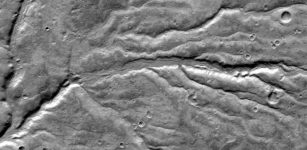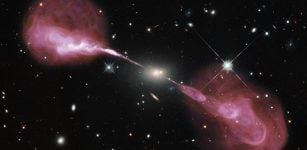Wandering Massive Black Holes In Dwarf Galaxies Are Not At The Centers Of Their Galaxies
Eddie Gonzales Jr. – MessageToEagle.com – Astronomers have new clues about the mechanisms that formed massive black holes in the early universe. They found 13 such black holes in dwarf galaxies located less than a billion light-years from Earth, using the National Science Foundation’s Karl G. Jansky Very Large Array (VLA).
 Artist’s conception of a dwarf galaxy, its shape distorted, most likely by a past interaction with another galaxy, and a massive black hole in its outskirts (pullout). The black hole is drawing in material that forms a rotating disk and generates jets of material propelled outward. Credit: Sophia Dagnello, NRAO/AUI/NSF
Artist’s conception of a dwarf galaxy, its shape distorted, most likely by a past interaction with another galaxy, and a massive black hole in its outskirts (pullout). The black hole is drawing in material that forms a rotating disk and generates jets of material propelled outward. Credit: Sophia Dagnello, NRAO/AUI/NSF
These dwarf galaxies, more than 100 times less massive than our own Milky Way, are among the smallest galaxies known to host massive black holes.
The scientists expect that the black holes in these smaller galaxies average about 400,000 times the mass of our Sun.
“We hope that studying them and their galaxies will give us insights into how similar black holes in the early Universe formed and then grew, through galactic mergers over billions of years, producing the supermassive black holes we see in larger galaxies today, with masses of many millions or billions of times that of the Sun,” said Amy Reines of Montana State University, in a press release.
They then used the VLA to make new and more sensitive, high-resolution images of 111 of the selected galaxies.
“The new VLA observations revealed that 13 of these galaxies have strong evidence for a massive black hole that is actively consuming surrounding material. We were very surprised to find that, in roughly half of those 13 galaxies, the black hole is not at the center of the galaxy, unlike the case in larger galaxies,” Reines said.
The observations indicate that the galaxies likely have merged with others earlier in their history. This is consistent with computer simulations predicting that roughly half of the massive black holes in dwarf galaxies will be found wandering in the outskirts of their galaxies.
“This work has taught us that we must broaden our searches for massive black holes in dwarf galaxies beyond their centers to get a more complete understanding of the population and learn what mechanisms helped form the first massive black holes in the early Universe,” Reines said.
Written by Eddie Gonzales Jr. – MessageToEagle.com Staff










